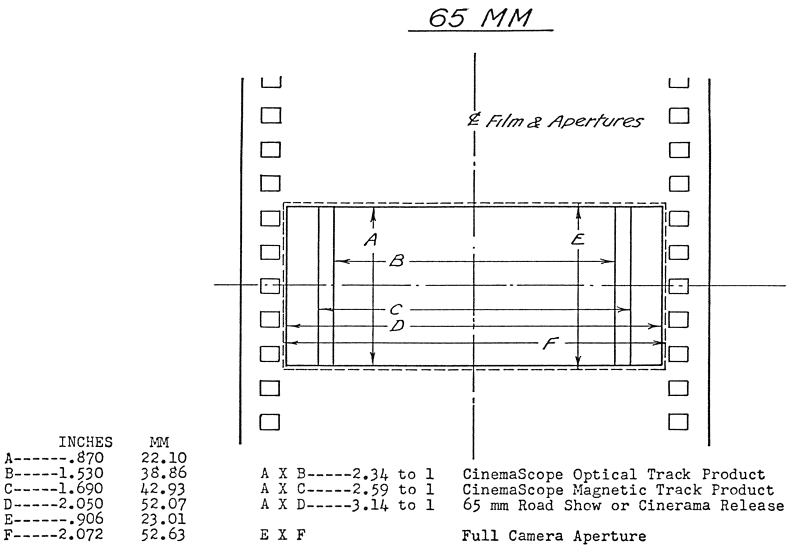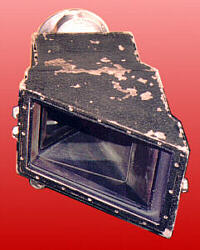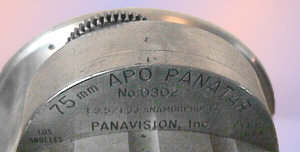The Moment of Conception:
MGM Camera 65 / Ultra Panavision 70
(And Some Clues About The Birth of TODD-AO)
Listed on the page entitled "Benefactors", you will find the names of many individuals who have provided all manner of materials and support that make The American WideScreen Museum possible. I hesitate to single out any one of these people for special mention but I must say that Cinerama Adventure producer-writer-director David Strohmaier has shared some of the most surprising finds due to his tenacious research and access to the archives of Cinerama, Inc. The sketch that I've reproduced below is one of those incredible finds that shouldn't have even been where he stumbled across it.
The sketch contains no date, author or company name, and only the numbers provide clues to what it is. Some of the numbers aren't even correct, indicating the haste with which the information had been compiled. I've made it obvious that the sketch pertains to MGM Camera 65, also known as Ultra Panavision by Robert Gottschalk, founder of Panavision, Inc.
 |
Let's retrace a bit of history and see how this piece of paper came to be.
As outlined in my coverage of Cinerama and Todd-AO, Michael Todd had been one of the primary forces that got Cinerama off the ground. He was vastly more involved than he was credited with being. When he became convinced that his personal financial situation threatened to delay or kill the production of This Is Cinerama, he bowed out of the company, at least publicly. Todd made a tidy profit from the sale of his shares in Cinerama Productions after the premiere of This Is Cinerama. Todd was so convinced of the power of Cinerama that he decided to create his own version, but in a less complex form, and thus was born the 70mm six channel stereo film format that has been a standard for almost 50 years.
But this sketch isn't about Todd-AO, at least not directly. So we examine a bit more of history. Todd and his new partners in Magna Film Corporation, Joseph Schenk, Richard Rodgers & Oscar Hammerstein utilized the services of Metro-Goldwyn-Mayer studios in testing and demonstrating the new system and in the production of the first Todd-AO presentation, Oklahoma!. MGM assigned their best cinematographer, Robert L. Surtees, as the director of photography.
Upon completion of Oklahoma!, all of the camera equipment went into storage at MGM. That studio had been searching for a flexible high quality photographic system that could be used to make CinemaScope films as well as offering the capability of even producing Cinerama films from a single negative. Todd-AO had a lot to offer but it wasn't the answer. Its biggest drawback was that it shot at 30 frames per second and there was no practical means of creating a 24 fps print from the negative. It also didn't offer quite a wide enough aspect ratio to extract either CinemaScope or Cinerama without wasting precious negative area.
The solution was relatively simple and that leads us to the sketch seen above. First they adopted Todd-AO's 65mm film format. This gave them an image with an aspect ratio of 2.28:1. To that they added an anamorphic squeeze of 1.25:1, yielding a maximum aspect ratio of 2.85:1 after reducing the frame height to hide splices. There was plenty of geography to provide images in any conceivable format. Not indicated on the sketch, but also a part of this design, was the fact that the camera speed would be held at 24 fps, assuring compatibility with all existing systems.
It is interesting to note that there is no mention of 70mm on the sketch. The reason for that is that at the time it was made, Todd-AO had not yet adopted the idea of using a wider print with magnetic stripes. Todd-AO had planned to use an interlock sound system just as Cinerama had, and just as all the studios had when using stereophonic sound up to that time. The lack of mention of 70mm tells us that the sketch was made no later than mid-1954 and probably well before that time.
MGM enlisted Panavision, Inc. to develop the new large format system. Panavision went to work, contracting with Mitchell Camera Co. to modify old 70mm Realife cameras to utilize the new 65mm negative, and designing and building the high quality anamorphic lenses.
 |  |
The approach that Panavision took in the design of the optics was novel, simple, and it yielded a very high quality lens. The heart of the new lens was a spherical objective produced for Panavision by Steinheil, an optical company founded in the mid 19th century in Germany. This lens was placed in a massive cast magnesium case which held a set of anamorphic prisms. The result was very large and quite heavy but it could not be faulted for its optical clarity.
The engraved information on the astigmatizer housing is in error. These lenses were always designed for a 1.25x squeeze but there were drawings and other documents that stated it was 1.33x, which was in error.
When all is said and done, we find that this historic little sketch describes a system that actually never existed. What came about was a system using 70mm prints, and with the exception of Raintree County in 1957 and the 35mm optical reduction prints of MGM's 70mm roadshow hits, it was not used as the standard method of making high quality CinemaScope product, the reason for that being that Panavision developed their own 35mm version of Fox's CinemaScope lens that offered a significantly improved release print. Such was the evolution of the early wide screen era of the 1950s.
Revised 24 January, 2013
|


